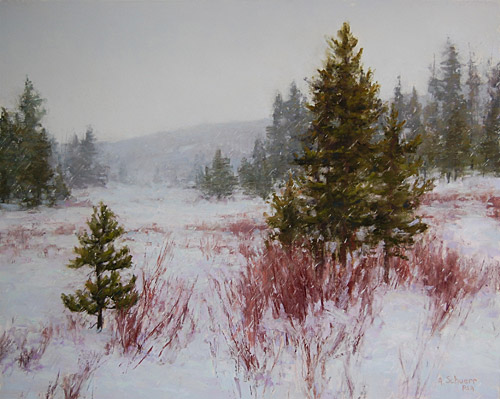Cathy Johnson’s Top Tips for Painting Falling Snow

You’ll find our guide to painting snow in our February issue (available online and at your favorite art store). Highlights include Cathy Johnson’s thoughts on the keys to managing color, shape and shadow in snow scenes. For those interested in an additional challenge, here are a few of Johnson’s favorite tips for capturing the look of snow as it falls:
• Sprinkle on salt. To create the appearance of snow-flakes, try adding a bit of salt into a wet wash in your sky or in a shadow area. The salt repels the water and pigment mixture, leaving light spots. The key to using this technique correctly is to make sure your wash is just right before adding the salt—if you add it too early while the wash is still too wet, the effect will be clumpy and harsh. You’ll also need to be sure to brush away the salt when the wash has dried completely. Otherwise it will continue to attract moisture. (Be careful that the wash is completely dry, or the salt and pigment can smear.)
• Spatter on white. To create a soft snowfall effect, spatter opaque white into a wet wash. The droplets will spread slightly, depending on how wet the mixture is. For a more hard-edged effect, let everything dry, then spatter on a thick mixture of opaque white and water. To create a directional snowfall effect, vary the way you hold the brush. If you hold the brush at an acute angle to the paper as you spatter, for instance,
the snowflakes will appear to be actually falling, or being blown.
• Mask the whites. You can also do a variation of the spattering technique using liquid masking. Before adding the first wash, spatter fine drops of masking on any areas where you want falling snow. Allow the masking to dry thoroughly, then paint in the rest of the design. Once the paint has dried, gently rub your fingers or a rubber cement pickup over the surface of the painting to remove the masking and leave perfect flecks of white.
• Draw the flakes. Finally, you can use a white colored pencil, either wax-based or water-soluble, to make quick, directional dots and dashes suggesting individual snowflakes. If you use the watercolor pencils, which are really water-soluble pigment encased in a wood pencil, you may want to wet the “lead” before each stroke to ensure that you make stronger marks.
MORE RESOURCES FOR ARTISTS
* Online
Seminars for Fine Artists
* Instantly download fine art magazines, books & video
workshops
* Sign up for your
Artist’s Network email newsletter & receive free fine art tips &
demos





Have a technical question?
Contact UsJoin the Conversation!